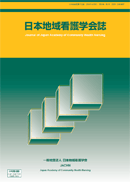Volume 22, Issue 2
Displaying 1-9 of 9 articles from this issue
- |<
- <
- 1
- >
- >|
Original Articles
-
2019 Volume 22 Issue 2 Pages 6-14
Published: 2019
Released on J-STAGE: April 20, 2020
Download PDF (1064K) -
2019 Volume 22 Issue 2 Pages 15-24
Published: 2019
Released on J-STAGE: April 20, 2020
Download PDF (1088K)
Review Article
-
2019 Volume 22 Issue 2 Pages 25-38
Published: 2019
Released on J-STAGE: April 20, 2020
Download PDF (1120K)
Research Reports
-
2019 Volume 22 Issue 2 Pages 39-49
Published: 2019
Released on J-STAGE: April 20, 2020
Download PDF (1076K) -
2019 Volume 22 Issue 2 Pages 50-58
Published: 2019
Released on J-STAGE: April 20, 2020
Download PDF (1109K) -
2019 Volume 22 Issue 2 Pages 59-68
Published: 2019
Released on J-STAGE: April 20, 2020
Download PDF (1094K) -
2019 Volume 22 Issue 2 Pages 69-78
Published: 2019
Released on J-STAGE: April 20, 2020
Download PDF (1122K)
Informations
-
2019 Volume 22 Issue 2 Pages 79-88
Published: 2019
Released on J-STAGE: April 20, 2020
Download PDF (179K) -
2019 Volume 22 Issue 2 Pages 89-96
Published: 2019
Released on J-STAGE: April 20, 2020
Download PDF (1012K)
- |<
- <
- 1
- >
- >|
